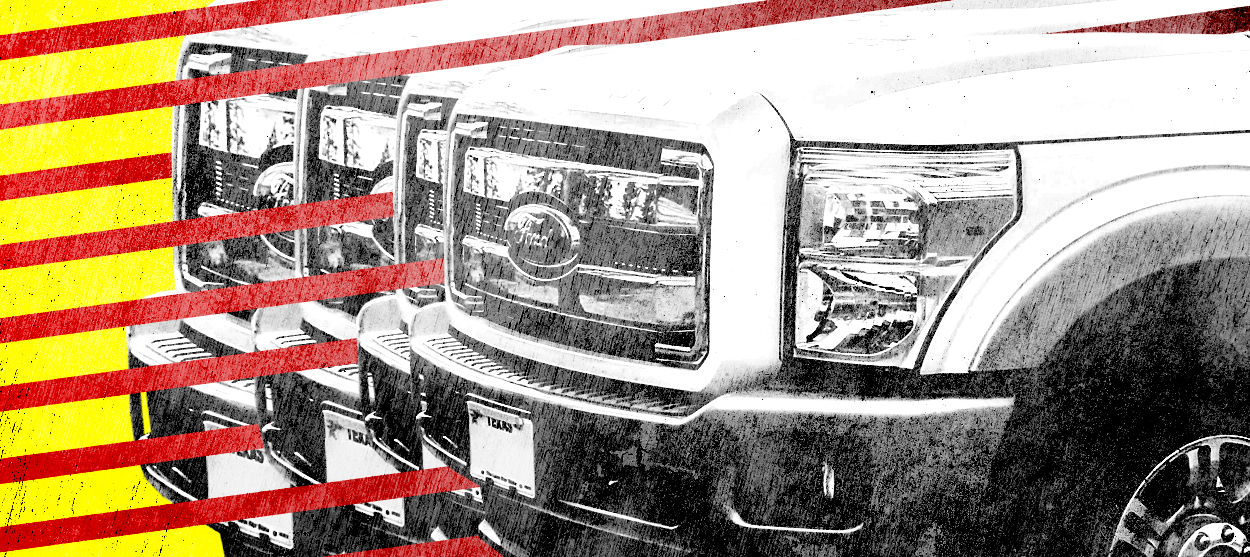The case against American truck bloat
A pointless design trend has turned trucks into dangerous pedestrian killers


When I was growing up in rural Colorado, my family had a classic work truck: a 1980 F-150 with the famous 300 cubic inch inline six-cylinder engine. It was often my task to fetch a load of sand for mixing concrete, or landscaping soil, or lumber for some project. It was a great truck, with only one problem — the oil pressure relief valve was a little sticky, so if you started it up cold and let it idle, the oil filter would sometimes explode. You had to give it some throttle immediately to shake loose the valve, after which it would be fine. It was just one of those little quirks that you adapt to with a hard-used piece of equipment.
That sort of truck is hard to come by in the consumer market these days. Trucks have gotten bigger, taller, gotten larger blind spots, and become much more powerful, luxurious, and expensive. Almost nobody even makes small pickups anymore, like the 1986 Toyota Hilux that I drove in college. The Toyota Tacoma, which used to be in that segment, is now almost as big as my old F-150.
This behemoth design trend — particularly the very tall, square front end seen in so many SUVs and trucks today — is both pointless and dangerous. Manufacturers have known for years that this style of vehicle is much more dangerous to pedestrians and cyclists, yet they keep making them bigger, taller, and heavier. Trucks and SUVs now make up fully 70 percent of all new cars sold in the U.S. Their bloated design is killing people, especially pedestrians.
The Week
Escape your echo chamber. Get the facts behind the news, plus analysis from multiple perspectives.

Sign up for The Week's Free Newsletters
From our morning news briefing to a weekly Good News Newsletter, get the best of The Week delivered directly to your inbox.
From our morning news briefing to a weekly Good News Newsletter, get the best of The Week delivered directly to your inbox.
When I made this observation on Twitter (in somewhat hyperbolic fashion), conservatives got steamed. Senator Ted Cruz (R-Tex.) accused me of being "afraid" of pickups. For the rest of the day, I got to enjoy good old conservative facts and reasoned debate: sexist and homophobic slurs, lurid fantasies about vehicular homicide, and repeated assertions that I drive a Prius — which appears to be the automotive equivalent of soy in the conservative mind palace. (I do not currently own a car of any kind, for the record.)
It does seem rather far-fetched to think that automakers are consciously building their biggest trucks to be more dangerous to pedestrians, but that is actually the case. To see why, let's start with some data. According to the Governors Highway Safety Association, there were 6,283 pedestrian fatalities in 2018, an increase of 53 percent compared to 2009 and the highest figure since 1990. That gives the U.S. a figure of 19 pedestrian deaths per 1 million population. By contrast, France and Denmark had rates of 7.0 and 5.2 that year — especially remarkable because walking around in Paris and Copenhagen is far more common than it is in most American cities. Indeed, not long ago the European Union had a considerably greater rate of pedestrian fatalities than America, probably because walking is so much more common there. But the E.U. has cut pedestrian deaths by about 40 percent between 2007 and 2018 (from over 8,000 to about 4,900), while the U.S. has gone the opposite direction. Oslo and Helsinki did not have a single pedestrian death in all of 2019.
What gives? One factor in pedestrian deaths generally is that American cities are, as a rule, designed to accommodate cars at the expense of any other method of travel. Anyone who chooses to walk or bike somewhere in our sprawling, car-clogged cities is taking her life in her hands. But that doesn't explain the recent increase. American cities have not been drastically re-engineered to be even more car-centered since 2009 — on the contrary, there have been some hesitant steps in the opposite direction.
No, the main reason for the jump in deaths is the increasing proportion of SUVs and trucks on the roads. As a major Detroit Free Press/USA Today investigation by Eric D. Lawrence, Nathan Bomey, and Kristi Tanner reveals, both manufacturers and federal regulators have known for years that big, tall vehicles are more dangerous to pedestrians and cyclists — something like 2-3 times more likely to kill when they hit someone. The reason is obvious: where a sedan will hit a standing person in the leg, usually causing them to roll onto the hood, a tall, flat-nosed truck will hit them in the torso, knocking them down and often running them over, and causing much more severe injuries. A study from the Insurance Institute of Highway Safety found that between 2009 and 2016, "fatal single-vehicle crashes involving SUVs increased 81 percent, more than any other type of vehicle." Yet as Lawrence, Bomey, and Tanner write, "A federal proposal to factor pedestrians into vehicle safety ratings has stalled, with opposition from some automakers."
A free daily email with the biggest news stories of the day – and the best features from TheWeek.com
It's not hard to see why automakers would resist considering pedestrian safety. Big trucks and SUVs have a larger profit margin, and the more of them are on the road, the more safety-conscious drivers will be pushed to buy one too, because you are dramatically more likely to die in an ordinary sedan if you get hit by an SUV. Trucks and SUVs do not make up 70 percent of automobile sales nowadays because Americans are now 70 percent contractors and HVAC repairmen. Nor has the average pickup gained 730 pounds since 2000 because 100 million people have taken up cattle ranching. The vast majority of SUV and truck drivers would have driven a sedan in previous ages, and for these people it's about looks, power, speed, and perceived safety for drivers. Thinking about pedestrians might upset this comfortable arrangement.
Furthermore, the specific design trend of the massive hood sticking way out in front of the driver, with a cliff-face front grille obstructing the view several feet out in front of the wheels, is entirely a marketing gimmick. The explicit point is to create an angry, aggressive face that will intimidate others, especially pedestrians. Don't take it from me, take it from the guy who designed the latest GM Sierra HD: "The front end was always the focal point... we spent a lot of time making sure that when you stand in front of this thing it looks like it's going to come get you. It's got that pissed-off feel," he told Muscle Cars & Trucks. "The face of these trucks is where the action is," marketing expert Mark Schirmer told the Wall Street Journal's Dan Neil, "a Ford has to say Ford from head on, a Chevy must shout Chevy. Every pickup has become a rolling brand billboard and the billboards are big." And as Neil discovered when he was nearly run down in a Costco parking lot, that massive grille creates a massive blind spot.
Actual commercial trucks generally do not harm their practicality by deliberately making it harder to see where you are going. The Isuzu NPR-HD (which incidentally has more than twice the payload capacity of the GMC 2500 Denali) does have a flat front, but because of its cabover design that places the driver above the engine. That gives it more cargo room for its length, a better turning radius, and an excellent field of view. Indeed, the truck's brochure specifically advertises how its visibility is much better without a long hood. Similarly, commercial-grade heavy trucks like the Ford F-650 or the Freightliner M2 106 do have a front-mounted engine, but their hoods slope down so the driver can see better, rather than senselessly creating an extra blind spot with sheet metal and air. It's easy to tell when a truck has been designed for work rather than for looking cool on your PC's desktop wallpaper.
So it's not exactly the case that American auto manufacturers sat down and said "how can we kill as many pedestrians as possible?" They just design, build, and sell pointlessly huge SUVs and trucks they know for a fact are much more deadly for pedestrians, and resist proposals to incorporate pedestrians into their safety rating. They make these energy-gobbling machines even more dangerous with intimidating design elements that harm their usefulness. As an obvious and easily foreseen consequence, America is suffering an epidemic of pedestrian fatalities. Automakers rate high profits and adolescent marketing campaigns above the lives of people walking the streets, just like cigarette companies did back in the day.
Now, I don't begrudge people wanting some aesthetic elements in a truck, nor do I begrudge people who actually do need them buying one today — indeed, no doubt many are just as frustrated as I am that you simply can't buy a sensibly proportioned truck that doesn't look like a 14-year-old's gaming rig anymore. But I do hold automakers responsible for deliberately ranking insecure faux-macho looks over the safety of pedestrians, as well as regulators for failing to rein them in. Trucks and SUVs could be designed more safely — for instance, Ford is reportedly working on a small truck/SUV crossover thing with a low front and downward-sloping hood.
Conservatives were quick to inform me that only beta male soyboys could possibly drive such a vehicle. It seems thousands of dead pedestrians — who are incidentally about 70 percent men — is just the price to be paid so the right can have another postmodern culture-war grievance in their eternal quest to own the libs.
Ryan Cooper is a national correspondent at TheWeek.com. His work has appeared in the Washington Monthly, The New Republic, and the Washington Post.
-
 Supreme Court revives Texas GOP gerrymander
Supreme Court revives Texas GOP gerrymanderSpeed Read Texas Republicans can use the congressional map they approved in August at President Donald Trump’s behest
-
 Boat strike footage rattles some lawmakers
Boat strike footage rattles some lawmakersSpeed Read ‘Disturbing’ footage of the Sept. 2 attack on an alleged drug-trafficking boat also shows the second strike that killed two survivors who were clinging to the wreckage
-
 Elizabeth Gilbert chooses books about women overcoming difficulty
Elizabeth Gilbert chooses books about women overcoming difficultyThe Week Recommends The bestselling author shares works by Tove Jansson, Lauren Groff and Rayya Elias
